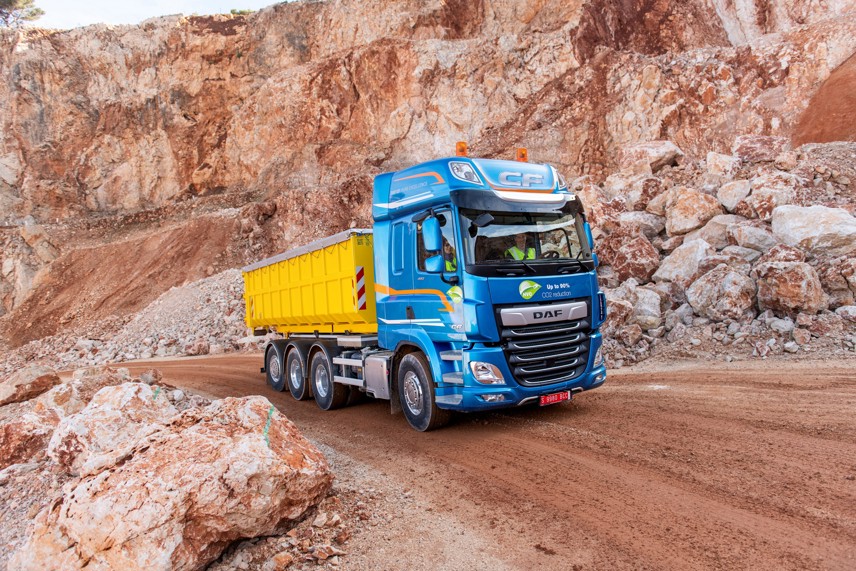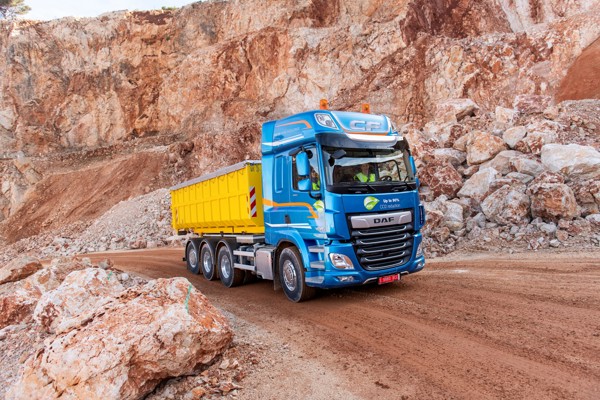Review
The transition from a double-drive-fits-all scenario to the emergence of single drives and tridems in the multi-wheeler market has taken a few years, but it is well and truly established now.
Driven by demand for more economical and emission-friendly transportation, it has made truck manufacturers and transport operators question some of the traditional ways of moving a product from one place to another in an efficient way.
The result has been a widening in the product offerings to six- and eight-wheeler operators, based around the various niches contained in this very diverse and demanding sector. This is where the Daf FAW multi-wheeler with a tridem configuration steps in, offering good off-road traction, improved payload over a three axle, and a lifting steered trailing axle for improved manoeuvrability.
Daf Trucks marketing manager Phil Moon says: “Many construction operators have moved from 6x4 to 8x4 to take advantage of the extra 4-5 tonne payload. But they have had to tolerate a reduction in easy access to tight locations. The FAW allows them to regain that manoeuvrability and take advantage of the extra payload.”
The FAW can be specified with either the CF or XF cab, the former in a 2,300mm wide day, sleeper and Space cab and the latter is a 2,490mm wide Space and Super Space cab. All cabs sit on a on four-point mechanical suspension with air as an option.
Inside the trim colour is a light beige, officially described as Dark Sand and it’s contrasted with very dark grey (virtually black), in fact it’s piano black on the XF. A “Comfort Air” seat comes as standard with a fixed co-driver seat, behind the driver is a single bunk without drawers, the cab climate is controlled by air-con and an auxiliary cab heater.
Remote-controlled central locking, electrically-controlled and heated mirrors and LED daytime running lights are also standard.
The CF cab offers the full range of Paccar MX-11/MX-13 Euro VI engine starting at 375PS, then 416PS and, finally, the top power rating of 456PS at 1,600rpm. Torque levels increase from 1,800/ 1,900Nm, 2,000/2,100Nm and 2,200/2,300Nm respectively, and all develop around 900-1,125 rpm.
The CF also offers the 12.9-litre Paccar MX-13 engine starting at 436PS, and 487PS to the most powerful 537PS, the respective torque figures start at 2,150/2,300 Nm, then 2,350/2,500 Nm and finally 2,500/2,600 Nm all developed at 900 rpm except for the 537PS which is 1,000 rpm. The XF models take the high output MX11 and all the MX 13 power ratings with both engines having a three-stage engine braking system controlled via a stalk on the righthand side of the steering wheel.
Behind the engines is the TraXon 12 speed automated gearbox with options of a manual 16 speed, 16 speed automated TraXon, and an option to have an overdrive on the top gear.
There are three chassis wheelbases – 4,050 mm, 4,550 mm, 5,550 mm – measured from the centreline of the front axle to the centreline of the bogie offering recommended body lengths between 6,000 mm to 9,460 mm for the CF and 5,790 mm to 8,500 mm on the XF, cab dependent.
The front axle is rated at nine tonnes fitted (10-tonne option) the rear double bogie has 13-tonne SR1360T single reduction axles are air suspended over eight air bellows and at the rear there’s an air suspended steered trailing axle, all having ventilated disc brakes controlled electronically via EBS.
Up to five tonnes greater payload matched to a similar turning circle to a three-axle is a good feature, the CF and XF maximum body/payload ranges from 20,894 kgs to 22,132 kgs.
Talking of the FAW’s tight turning circle if you look at the Daf 8x4 FAD double drive it has a kerb to kerb of 20.4 but the FAW is 15.4m. This is due to the front axle steering angle increasing by six degrees, achieved by the removal of the second steered drag link arm and the wheelbase has been brought forward.
Finally, the electro-hydraulic steered trailing axle (EHS) ensures a tight turning circle, indeed the Daf marketing team believe this accounts for around 33% of all their multi-wheeler sales.
Looking at the XF480 on a rigid chassis it seems out of proportion, but as you get into the cab all is forgotten with the wide-open spaces of the XF Comfort cab.
The standard beige and piano black interior are appealing to the eye, the Xtra leather air suspended driver’s seat comes complete with armrest and adjusting the steering wheel ensures a comfortable driving position.
The instrument panel has a colour coded circular rev counter to the right and speedo on the left, the fuel and water temperature gauges are above with a LCD driver information panel in the middle. Cruise control, speed limiter and Bluetooth functions, are controlled via the switches on the steering wheel with the wipers and engine brake operated via the left and right stalks, respectively.
On the left panel is a short stubby park brake lever and optional Sat Nav screen with the air conditioning control underneath close to the gearbox rotary switch.
The low engine hump offers access to the very thick Xtra Comfort lower mattress complete with 65-litre drawer.
Going along Gloucestershire ‘A’ roads produced almost no in-cab noise and the combination of cruise control with engine brake made for a relaxed drive.
As we drove along the dual carriageways the MX13 487PS sat at 56mph comfortably and well within the green economy zone. Even when driving down the very narrow roads and in small towns the visibility was good considering we were in such a large cab.
Perhaps the biggest issue was my poor driving skills in the first 10 minutes as I got used to the very noticeable effect of the rear steer and its increased steering angle, which takes a bit to get used to. In the first few minutes the truck tended to cut into the corner and kerb slightly, but this was soon cured by reducing the steering input and, after that early lesson, all was well!
Later in the day we entered a private quarry to test out the tighter turning circle and, having switched to manual drive, the truck took corners that would only be possible for a conventional eight-wheeler with a reverse and shunt manoeuvre.
The FAW is the relatively new kid on the block and offers a greater payload potential against a six-wheeler, better turning circle and has one of the largest cabs on the market, why wouldn’t you want to try it?

















